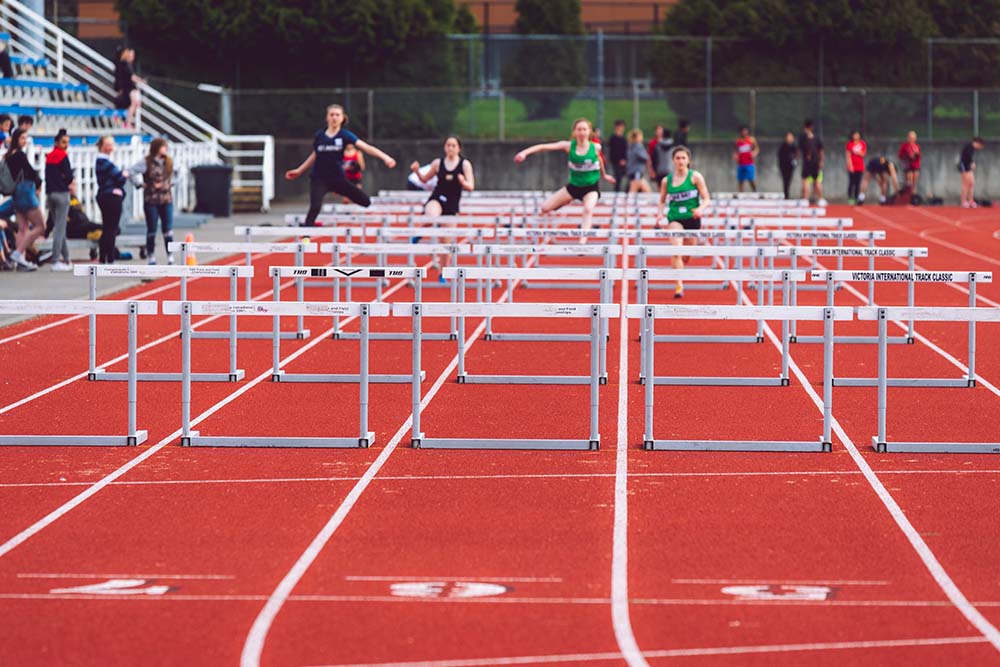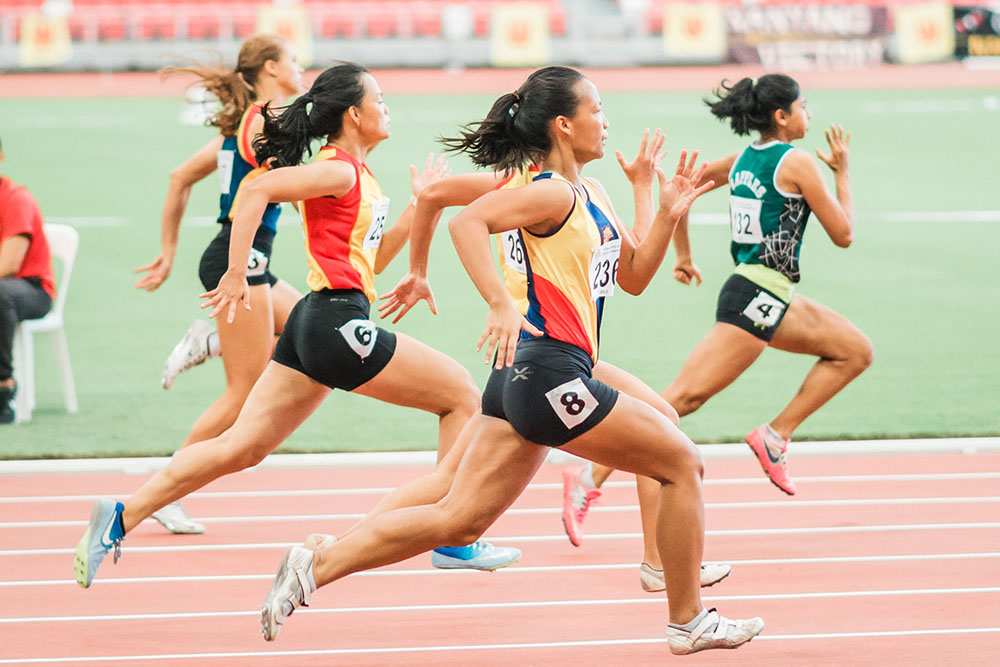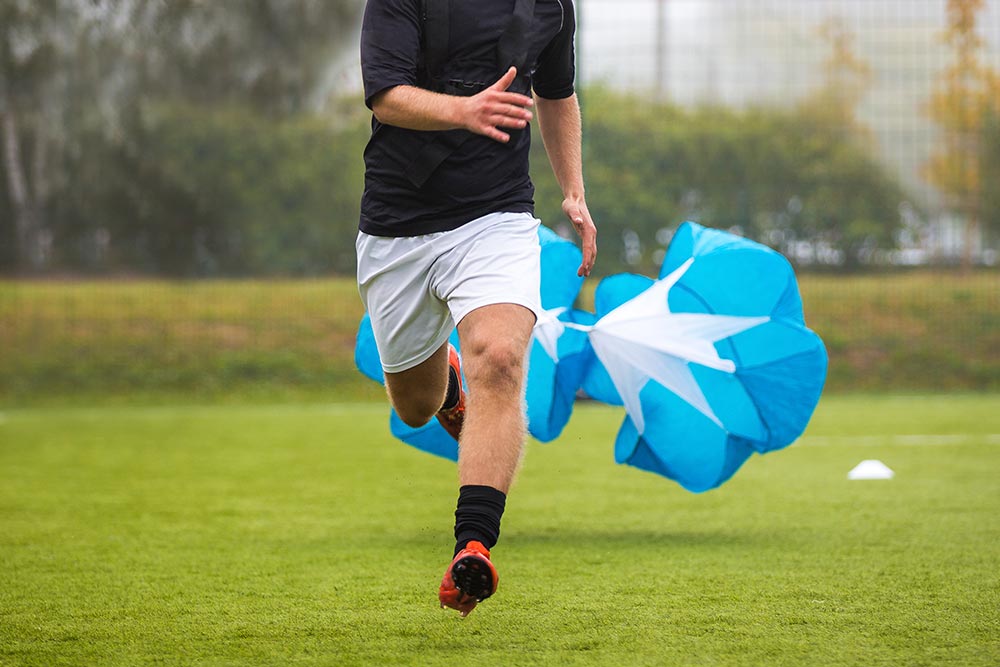5 Best Gym Exercises to Improve Acceleration
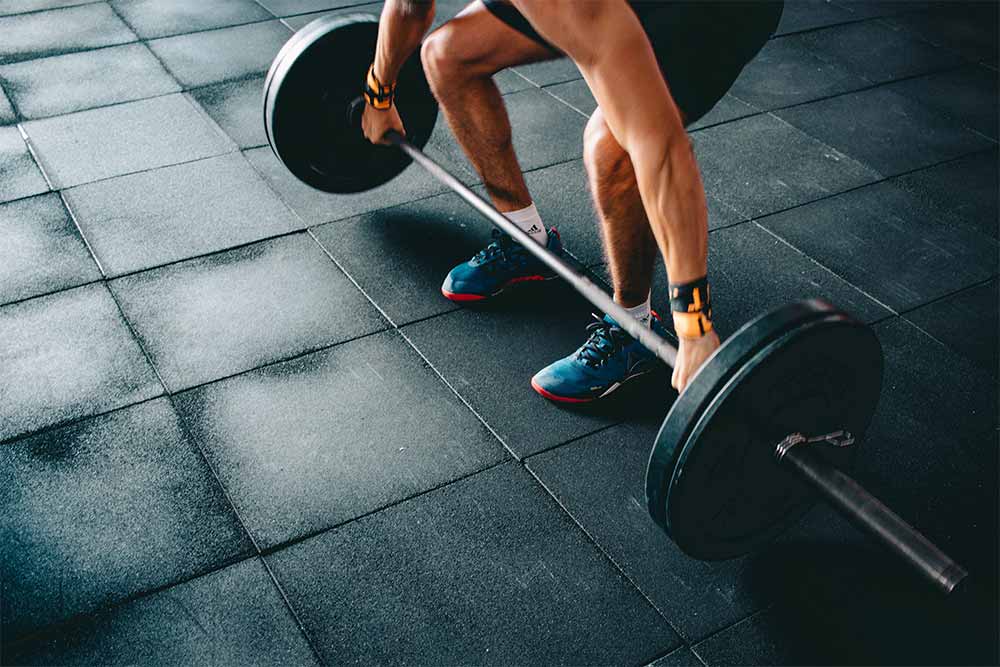
Hunter Bennett
As many of you would already know, a sprint event can be broken down into four distinct phases – the start phase, the acceleration phase, the maximal velocity phase, and a phase of deceleration.
Although each of these key phases holds specific importance within the realm of sprinting success, coaches and athletes alike would agree that the acceleration phase is without a doubt the most important.
Which makes perfect sense.
Your likelihood of success within a given race is going to increase the more time you spend running at maximal velocity.
And given that acceleration describes the rate at which you increase your sprint speed, the better your acceleration, the faster you will reach your maximal velocity – and therefore the more time you will spend at that maximal velocity.
So, in short, if you enhance your acceleration, you enhance your sprint performance. Simple.
How Can You Improve Acceleration?
Something that we have discussed at length in previous articles is the fact that acceleration can be broken down into two components
- The amount of force that you can put into the ground each step
- How quickly you can apply that force each step (Mackala, 2015).
While this is undoubtedly quite simplistic, it does tell us two extremely important – to maximize acceleration performance you need to be able to put a large amount of force into  the ground each step, and that you need to be able to express that force quickly and efficiently.
the ground each step, and that you need to be able to express that force quickly and efficiently.
With this in mind, we actually have the ability to improve acceleration performance through two somewhat distinct training methods.
- Gym based training: which improve strength and other force production capabilities (Wisloff, 2004)
- Track based training: which improve movement efficiency and the ability to express force rapidly during sprint specific movement tasks (Morin, 2011)
Given that we have already discussed track-based methods in a previous article, today we are going to be looking at the best gym-based training methods to enhance acceleration. More importantly, we are going to look at what we believe to be the best 5 gym exercises for enhancing acceleration.
Related Article: Agility & Weightlifting for Sprinters | ForeverFitScience Sprinting Tips & Tricks
The Benefits of Gym Based Training for Acceleration
Gym based training enhances your acceleration capacity through two key mechanisms: Improving your maximal force production capabilities and improving your rate of force production capabilities.
And this is done by combining strength and power training methods.
Strength Training to Improve Force Production
When we talk about increasing strength, we are essentially discussing increasing the maximal amount of force you can put into the ground – which as we have already discussed, is key when it comes to improving acceleration (Delecluse, 1997).
This again makes a whole lot of sense.
As acceleration comes down to your ability to produce force quickly, the more force you have available, the greater your potential for acceleration becomes.
As a result, using gym-based training to develop absolute strength is integral.
Within this, it is in your best interest to prioritize compound lower body strength movements such as squats, hip thrusts, and split squats (and their many variations), and train them using basic strength sets and reps schemes (such as 3×3, 5×5, or 6×2), once or twice per week.
These key lower body movements train the big powerful muscles involved during the acceleration phase, while simultaneously replicating the joint actions that occur while accelerating out of the blocks.
But this modality of gym training only improves our absolute force production capabilities – which really leads us quite nicely into our second component of gym-based training.
Power Training to Improve Rate of Force Development
Strength training is essential to increasing the maximal amount of force you can produce – however, you still need to learn how to apply that force rapidly
This ability has been coined ‘rate of force development’ (or RFD for short), which is enhanced by adding explosive lower body movements into your lower body gym training (Ayers, 2016).
Fantastic exercises that do this effectively include jump variations (such as box jumps, broad jumps, and single leg box jumps), plyometric exercises (such as lateral bounds, tuck jumps, and depth drops) and Olympic lifting variations (such as cleans, snatches, and their many variations).
These exercises are fantastic as they use either bodyweight or lighter weights to add external resistance to the movement, allowing you to train as explosively as possible. As a bonus, this will also improve your ability to absorb and release elastic energy.
There are two real considerations when discussing this type of power training.
Firstly, these exercises should not be performed to failure. To maximize their effectiveness, they need to be performed as fast and as explosively as possible.
Secondly, they should be performed at the start of your gym training session, before your more strength dominant movements. This is because fatigue inhibits your ability to produce force quickly – as such, it will also inhibit the desired training effect associated with these exercises.
Best 5 Gym Exercises to Improve Your Acceleration
If we take the above into consideration, there are five core gym exercises that we recommend you integrate into your gym training. These movements have direct carryover to acceleration performance, making them ideal for the novice and expert alike.
Moreover, they are relatively simple to perform, meaning that they can be used to enhance performance almost immediately.
Box Jump
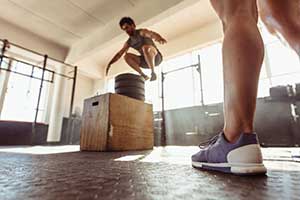 Box jumps are a fantastic exercise that strictly works on the explosive power side of force production continuum. Because this exercise uses your body weight as the only form of external load, it offers the perfect means of maximizing your RFD.
Box jumps are a fantastic exercise that strictly works on the explosive power side of force production continuum. Because this exercise uses your body weight as the only form of external load, it offers the perfect means of maximizing your RFD.
Start by standing in front of the box in an athletic position. Your feet should be set about a shoulders width apart, and you should be a comfortable distance from the box. When you feel ready to commence the jump, rapidly descend into a quarter squat while swinging your arms downward. From this bottom position, rapidly jump up onto the box, ensuring that you fully extend your hips and swing your arms upwards – landing on top of the box gently.
The key here is to be soft on the landing – envision the way a cat lands on the ground.
Similarly, don’t get caught up worrying about how high the box is. The goal here is to jump as high as you possibly can. This isn’t going to change as the box gets higher.
Hang Power Clean
Although the hang power clean is often considered a precursor to some of the more technically demanding Olympic lifts, it is also a fantastic exercise in its own right.
Using light relative loads, it provides a way to enhance muscular power and RFD, while also reinforcing triple extension at the hip, knee, and ankle – which is imperative during the acceleration phase of sprinting.
Start by standing tall and holding the bar with an overhand grip. Your feet should be shoulder width apart, and your eyes should be looking forward.
Commence the movement by sitting your hips back and bending your knees slightly, as if you were preparing to perform a vertical jump. Once the bar reaches the middle of your thighs, jump upwards by rapidly extending your legs and driving your feet into the ground. As you reach full extension, you should come up onto your toes, while ‘shrugging’ the bar upwards.
Proceed to drop your body under the bar by rapidly rotating your hands and elbows (moving into the front rack position). As you catch the bar, allow your hips to shift back and down slightly to help absorb the weight of the bar. Keep your elbow and chest up tall, and proceed to stand up tall, finishing off the movement.
This is one rep.
Related Article: The Biomechanics of Sprinting
Front Squat
When it comes to maximizing performance, the front squat is king.
While it is often overlooked for its big brother, the back squat, it arguably offers greater benefit for sprinters. You see, the front squat better replicates the torso and hip position apparent during acceleration – making it the perfect way to build strength and optimize force production in this position.
This movement is performed with the bar held in the ‘front rack’ position. The bar should be resting on the shoulders, with your fingers under the bar (just wider than the shoulders). Your chest and elbows should be up tall throughout the duration of the movement.
Start with your feet just wider than shoulder width, and your toes pointed out slightly. Proceed to descend into a squat by dropping straight down between your heels. Keep your chest and elbows up tall throughout the duration of the movement.
Control the descent and reach the bottom position (top of thighs parallel to the ground) in a smooth manner. From here proceed to drive your feet into the ground and come up as explosively as possible, returning to the starting position.
Hip Thrust
The hip thrust is such an effective exercise that we have already written an entire article on its benefits. But, in short, the hip thrust offers a way to develop strength and maximize horizontal force production – both of which are integral to acceleration.
For this exercise, begin seated on the ground with your upper back resting against a bench directly behind you. A loaded barbell should be placed over the crease of your hips. We strongly recommend placing either a foam pad or a squat pad between the bar and your legs to make this movement a little bit more comfortable.
Proceed to lean back against the bench and press your hips into the ground. Your upper back should be resting on the bench, the bar should be elevated a couple of inches on off the ground, and your feet should be flat. Then begin the movement by driving your feet into the ground, thrusting your hips up into the bar until they reach full extension – then reverse the motion to return to the starting position.
Some key aspects of this movement that we want to reinforce is that your chin should be tucked against your chest throughout the entirety of the movement, and the extension should come from your hips and not your lower back.
Bulgarian Split Squat
Our final exercise is one of the most important. The Bulgarian split squat (also known as the rear foot elevated split squat) is a single leg squatting exercise where the rear foot remains supported. This means that while it still replicates the demands of sprinting closely and allows the development of hip stability, it can also be loaded heavy.
And the result?
An exercise that offers the perfect combination for building muscular strength, increasing neuromuscular coordination, and enhancing acceleration mechanics.
Start by standing approximately 1-2 feet away from the bench behind you, while holding onto two dumbbells. Slowly reach one leg back behind you and rest the top of your foot gently on the bench. This is your starting position.
From here, gradually descend under control until your back knee lightly touches the ground. Make sure to keep your torso neutral, and your hip flexed slightly in the bottom position. Finish the movement by pushing the grounded leg into the floor, driving back up into the starting position.
Putting it all together
In my mind, these five exercises tick all the boxes when it comes to maximising acceleration. They allow the development of power and strength in such a way that closely replicates the demands of the acceleration phase of sprinting.
But a large part of this is making sure that they are structured appropriately during your gym session. With this in mind, we have put together an example program that can be completed 1-2 times per week in the gym.
The loading schemes and rest periods have been optimised for the development of power and strength, respectively. It would be in your best interest to progress over time by increasing the speed or adding load to the movement, rather than increasing the number of repetitions.

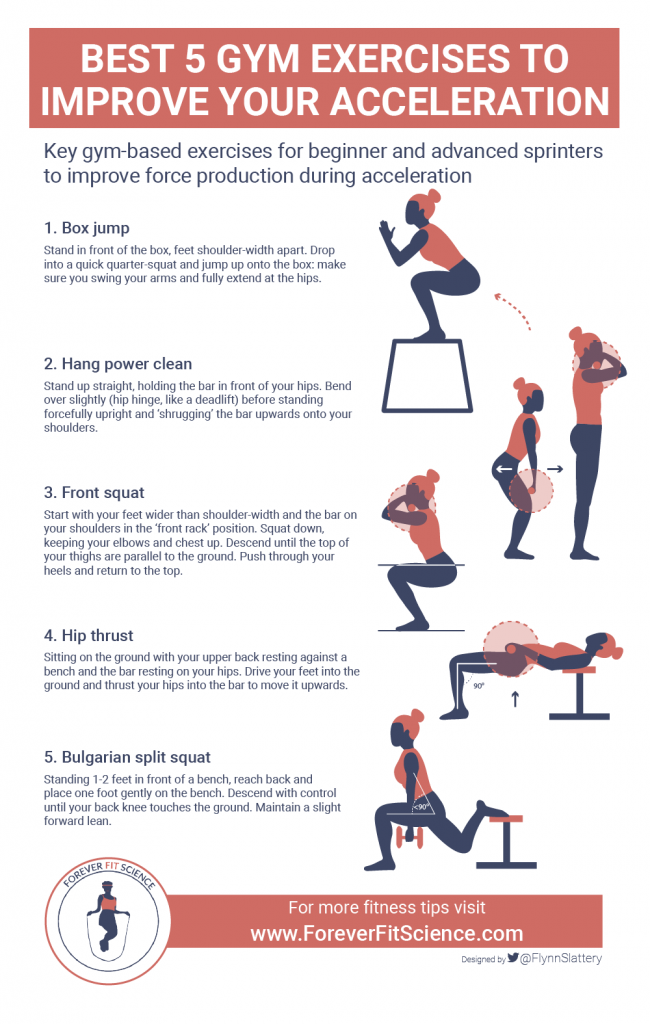
Bonus Exercise: Resisted Vertical Jump
The above training programs offer one of the best ways to enhance acceleration with minimal equipment. There is one other exercise that we wanted to touch on briefly. There is research to suggest that there is an extremely strong association between vertical jump height and acceleration performance (McFarland, 2016).
As a result, performing training that includes lightly loaded vertical jumps can also enhance short distance sprint performance in a very big way (Marián, 2016).
The easiest way to perform these is by using a piece of equipment known as a Vertimax. The Vertimax allows you to easily and effectively add band resistance to your vertical jump exercises.
With all this in mind, if you did have such a piece of equipment available, you would be able to add this exercise into your program immediately after box jumps (and subsequently, before hang power cleans). They would then be performed in a very similar manner to the box jumps. You would simply be jumping straight up into the air (rather than onto the box). Then, you would land back on the Vertimax in your starting position.
The keys with this exercise are to move as explosively as possible and make your ground contact times between repetitions minimal. This will not only enhance RFD, but also improve your ability to store and release elastic energy.
Perform for four sets of five repetitions.
Take Home Message
When it comes to enhancing sprint performance, improving acceleration is key. By maximizing the amount of time that you spend at maximal velocity, a good acceleration phase sets you up for sprinting success.
The five exercise within this article are hands down some of the most effective for developing the qualities that underpin acceleration performance. Give them a go and reap the rewards!
References
Maćkała, Krzysztof, Marek Fostiak, and Kacper Kowalski. “Selected determinants of acceleration in the 100m sprint.” Journal of human kinetics 45.1 (2015): 135-148.
Wisløff, U., et al. “Strong correlation of maximal squat strength with sprint performance and vertical jump height in elite soccer players.”. British journal of sports medicine 38.3 (2004): 285-288.
Morin, Jean-Benoît, Pascal Edouard, and Pierre Samozino. “Technical ability of force application as a determinant factor of sprint performance.”. Medicine and science in sports and exercise 43.9 (2011): 1680-1688.
Delecluse, Christophe. “Influence of strength training on sprint running performance.” Sports Medicine 24.3 (1997): 147-156.
Ayers, J. L., et al. “Hang cleans and hang snatches produce similar improvements in female collegiate athletes.” Biology of sport 33.3 (2016): 251.
McFarland, Isaiah T., et al. “Relationship of two vertical jumping tests to sprint and change of direction speed among male. And female collegiate soccer players.” Sports 4.1 (2016): 11.
Marián, Vanderka, et al. “Improved maximum strength, vertical jump and sprint performance after 8 weeks of jump squat training with individualized loads.” Journal of sports science & medicine 15.3 (2016): 492.
JOIN OUR NEWSLETTER
You Might Like:

